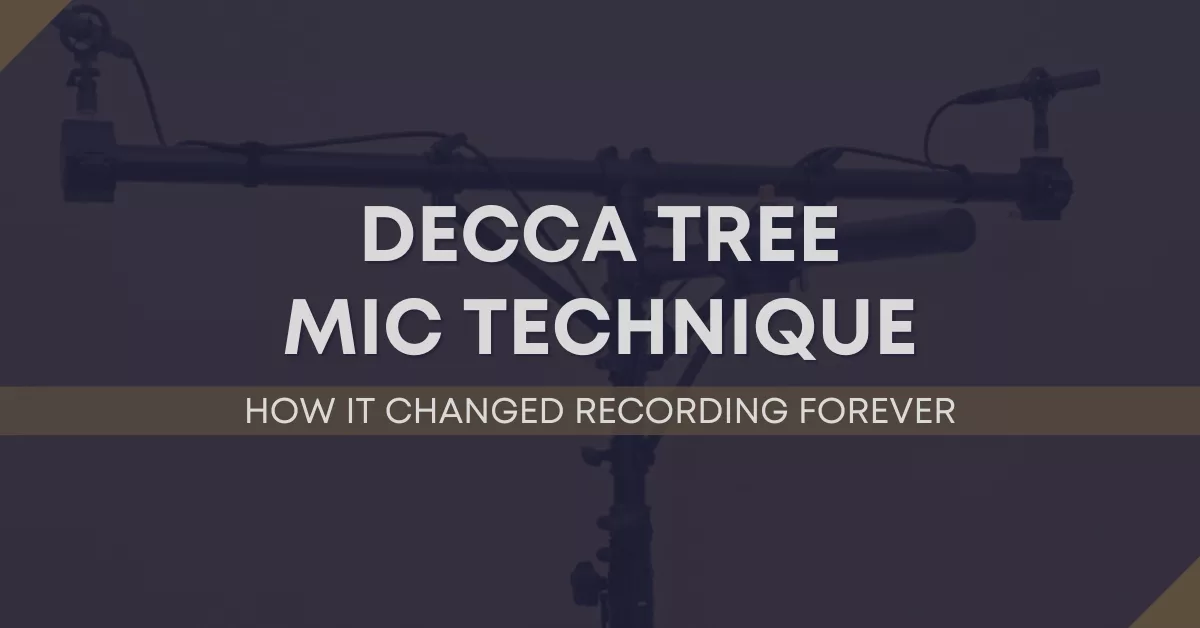
When it comes to capturing the sound of a live performance or studio recording, the right microphone setup can make all the difference.
One technique that has stood the test of time is the Decca Tree, a stereo microphone configuration that has been used in classical and orchestral recordings for decades.
In this post, we'll explore the history behind the Decca Tree, how to set it up, the best mics to use, recording applications, and the pros and cons of this iconic miking technique.

The Decca Tree was first used in the 1950s by engineers Roy Wallace and Arthur Haddy at Decca Records, who were looking for a way to capture the sound of a large orchestra in a natural and realistic way.
They came up with a stereo microphone setup consisting of three omnidirectional microphones arranged in a triangle configuration, with the center mic placed slightly lower and in front of the other two. This allowed for a wide stereo image and a sense of depth and dimensionality that was previously difficult to achieve with a traditional stereo miking technique.
Over the years, the Decca Tree has become a staple in classical and orchestral recording, and has been used on countless albums and film scores. The technique has also been adapted for other genres of music, such as jazz and pop.

For the classic Decca Tree setup, the configuration requires careful placement of the microphones in relation to the performers and the room acoustics.
Three microphones will be used and mounted in a triangular position, preferably with a proprietary mic stand. The center microphone should be placed slightly in front and below the left and right mics. The distance between the microphones will depend on the size of the ensemble and the acoustics of the room.
Though there are several variations of the Decca Tree configuration, most agree on this one location. Put the mics around 3 meters high above the conductor's position. This will capture the performance from the audiences perspective.
When it comes to mixing the Decca Tree, it is super simple. The center mic will act as a mono microphone and be panned right up the middle. The left and right mics will be panned hard left and right. The idea is that if you take away the center mic, you should feel a loss of focus and definition in the mix.
Tip: You can use 5 microphones to increase the coverage of the stereo recording. Mics 4 and 5 will go on the outside of the left and right mics and be placed equal distance away. They can be placed at the same position or spaced slightly behind them.

The Neumann M 150 is a large-diaphragm tube mic that delivers a warm, natural sound that captures every nuance of your performance. Its omnidirectional polar pattern provides a smooth, even frequency response and a spacious, three-dimensional sound image. With its unique combination of vintage warmth and modern precision, the M 150 is the perfect microphone for capturing vocals, acoustic instruments, and orchestral recordings.

The AKG C414 is a versatile and legendary condenser microphone that has been trusted by recording professionals for decades. With nine selectable polar patterns, a switchable high-pass filter, and a -20dB pad, the C414 can handle any recording situation with ease. Its accurate and transparent sound makes it ideal for capturing vocals, acoustic instruments, and orchestras. The C414 also features a rugged and durable design that can withstand the rigors of studio and stage use.
When it comes to choosing the best microphones for the Decca Tree setup, there are a few factors to consider.
Since the Decca Tree is an omnidirectional configuration, it's important to choose omnidirectional mics that have a wide frequency response and a low self-noise level. Popular choices include the Neumann M 150, the AKG C414, and the Shure KSM141.
Tip: The microphones should be matched to ensure a consistent sound across all three channels.
Related Article: The Top 5 Best Microphones for Recording Vocals In 2024
The Decca Tree configuration is well-suited for recording large orchestral ensembles, choirs, and other acoustic music genres. It can also be used in smaller chamber ensembles and solo recordings. The technique is ideal for capturing a natural and realistic sound, with a wide stereo image and a sense of depth and space.
Like anything in life, there are pros and cons to using the Decca Tree miking technique. Knowing these will help you decide if this technique is right for you and your application. Let's first start with the pros.
Related Article: What Is Phase Cancellation? Don’t Let It Ruin Your Recordings!
In conclusion, the Decca Tree miking technique is a popular and effective method for recording ensembles, from orchestras to smaller chamber groups. It offers a natural and spacious sound that can capture the essence of the ensemble and the room in which it is recorded.
While the technique does have some drawbacks, such as its reliance on room acoustics and the need for a skilled audio engineer, it remains a versatile and cost-effective option for recording studios.
With the right setup and expertise, the Decca Tree technique can produce stunning results and help to create a more immersive listening experience for the audience.
"Some of the links within this article are affiliate links. These links are from various companies such as Amazon. This means if you click on any of these links and purchase the item or service, I will receive an affiliate commission. This is at no cost to you and the money gets invested back into Audio Sorcerer LLC."